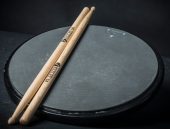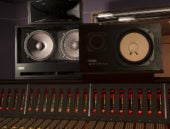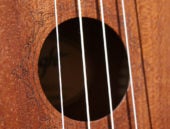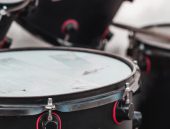-
As satisfying as it is to watch your stompbox collection grow, the more crowded your board, the more you need to start thinking about the order of the effect chain, otherwise, there’s a big chance that your sound quality will start to suffer. In this blog, I’ll offer five tips to help you set up your effects pedals in the best possible order and make sure you’re getting nothing but the best possible sound.
-
Even if you’ve been drumming for a while, there’s a chance you’ve never thought about the way you hold your drumsticks. Since there are a few rules of thumb that can actually help you hone your skills, we’ve compiled a humble list of stick-based tips and tricks for you in this blog.
-
So, you play keyboard and you’d like to sing along. But is it even possible to plug a microphone directly into your keyboard? That depends entirely on your keyboard, but even if it does have a microphone input there are still a few things to bear in mind or look out for.
-
So, you just entered the world of studio gear and you want to pick up a pair of studio monitors. How different are these compared to your old hi-fi system or that CD player catching dust in your living room? How does a studio setup work? And do I need an amplifier with my new set of speakers? Answers to these questions and more below!
-
Back in the day, ribbon microphones were not only expensive but incredibly delicate, and generally, were only built and maintained by the studios that used them. In America, RCA records built their own ribbon microphones, while the BBC built their own Coles microphones. Of course, these days, you can find a massive range of affordable models available, and most of them are a lot more hard-wearing and less delicate than their ancestors. Here, I’ll go over the pros and cons of using the infamous ribbon microphone so you can make up your own mind.
-
Want to make your own beats in the comfort of your own bedroom? Maybe you want to start producing beats to help out other artists, make their dreams come true, and in turn, see your own dreams come true? Here, guest-blogger and producer Daddynervs offers a guide through the first steps you need to take to start building your own beats.
-
The way you play your instrument has got just as much to do with the overall sound as the wood that it’s made of and the strings that it has. There are a lot of fundamental things that new players often miss when trying to find a good sound and today, guest blogger Matthew Quilliam shows us five subtle but effective ways to improve your overall tone when playing your ukulele.
-
If you’re a drummer, then there’s at least one drum that you can never do without: the snare. While you might be familiar with the array of different percussive sounds you can get out of a snare, if you’re a beginner, you might not necessarily know how to access all of them. Even a small adjustment in your playing can make a snare drum sound completely different, and here, I’ll offer up some essential tips that will help you get to know your snare a little better.
-
The fretless bass is actually pretty rare in the bass world, since most bassists simply prefer fretted models. Listen to the bass of any current hits and you’re likely to be listening to a fretted bass. But there’s no doubt that the fretless bass packs unique character and there are plenty of devotees out there that refuse to play anything else. So, what’s the deal with the fretless bass – what are the good bits? And what are the not-so-good bits?
-
Granted, the ideal drum kit set-up is highly personal. But that doesn’t mean there aren’t a few guidelines that you need to follow. To help you find a comfortable, practical and most of all style-matching set-up, I’m going to show you a couple of different takes on the standard drum kit configuration!
-
Whether it’s a single-coil or a humbucker, practically all electric guitar pickups and bass pickups are equipped with a magnet that captures the vibrations of the strings. While magnets don’t boast any sonic properties of their own, the specific type of magnet inside any guitar or bass pickup certainly helps to shape the overall sound of the instrument. Since most pickups feature either an alnico or a ceramic magnet, I’m going to highlight the differences between both and tell you how the well-known Alnico V models compare to Alnico II variants.
-
If there’s one thing that sets an experienced studio engineer apart from a novice, it’s how well they mix the lower-frequency instruments of a track. Here, I’m referring to the kick drum, the bass, the lower sonic regions of the guitars, synths, and keyboards – since it’s all of this that makes up the low-end, and it’s these lower frequencies that are harder to mix than any other part of the frequency spectrum. But why? And how do you get that thick and full, punchy layer that’s going to sound awesome on any set of speakers you put it through? Read on to find out.
Sign up for the Bax Music Blog Update!
Just fill in your email address and we'll drop a fresh instalment of blogs in your mailbox every month so you never have to miss out again.
Subjects
About Bax Music
Bax Music is your go-to online music store in the UK with more than 48,000 bits of gear and accessories in stock. More than 1,000 brands and a 26,000m2 warehouse packed with musical instruments, DJ and studio gear, headphones, speakers and lighting. Ordered before 10 PM? Receive delivery in 2 - 4 business days.
Wanted: Guest Blogger!
Become a Video Reviewer!
Recent Posts
 NAMM 2025 – Top 10 Releases30 January 2025
NAMM 2025 – Top 10 Releases30 January 2025 Picking Out the Right PA System for a Wedding29 January 2025
Picking Out the Right PA System for a Wedding29 January 2025 The History and Features of Hard Rock and Heavy Metal29 January 2025
The History and Features of Hard Rock and Heavy Metal29 January 2025 How to Start a Band29 January 2025
How to Start a Band29 January 2025 How to Be a Wedding Singer28 January 2025
How to Be a Wedding Singer28 January 2025 Does a Good Musician Make a Good Band Mate?28 January 2025
Does a Good Musician Make a Good Band Mate?28 January 2025 Hybrid Drums: The Best of Both Worlds28 January 2025
Hybrid Drums: The Best of Both Worlds28 January 2025 How Do You Tune a Mixer, Speakers and Amplifier to Each Other?28 January 2025
How Do You Tune a Mixer, Speakers and Amplifier to Each Other?28 January 2025 Relic’ing a Guitar or Bass: How and Why23 January 2025
Relic’ing a Guitar or Bass: How and Why23 January 2025 A 5-Step Guide to Clean Recordings for Budding Mixing Engineers23 January 2025
A 5-Step Guide to Clean Recordings for Budding Mixing Engineers23 January 2025
Recent Comments
- Marnix | Bax Music on Special Chords: Rare but Useful
- Fungk on Headless Guitars: The Pros & Cons
- Johnny B. on Special Chords: Rare but Useful
- Black Beauty 16 on The Snare Buzzes When I Hit the Tom: Can I Fix it?
- Stefan | Bax Music on Phantom Power: This is What You Need to Know
- Marnix | Bax Music on How To Connect A Record Player To An Amplifier Or Pair Of Speakers
- Lily on How To Connect A Record Player To An Amplifier Or Pair Of Speakers












